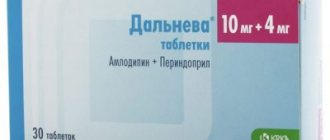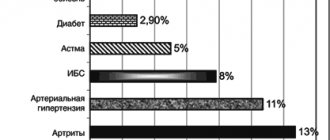Edarbi clo
A combination drug that includes an angiotensin II receptor antagonist (azilsartan medoxomil) and a thiazide-like diuretic (chlorthalidone). The simultaneous use of two active substances leads to a more pronounced decrease in blood pressure compared to taking each of them in monotherapy. When taking the drug once a day, an effective reduction in blood pressure is achieved within 24 hours.
Azilsartan medoxomil is a specific angiotensin II type 1 (AT1) receptor antagonist. Angiotensin II is formed from angiotensin I in a reaction catalyzed by angiotensin-converting enzyme (ACE, kininase II). Angiotensin II is the main vasoconstrictor factor of the RAAS, its actions include vasoconstriction, stimulation of aldosterone synthesis and secretion, increase in heart rate and sodium reabsorption by the kidneys.
Azilsartan medoxomil is a prodrug. It is quickly converted into the active azilsartan molecule, which selectively prevents the development of the effects of angiotensin II by blocking its binding to AT1 receptors in various tissues, for example, vascular smooth muscle and the adrenal glands. Therefore, its action is not related to the angiotensin II biosynthetic pathway. AT2 receptors are also found in many tissues, but they are not involved in the regulation of the cardiovascular system. The affinity of azilsartan for AT1 receptors is 10,000 times higher than for AT2 receptors.
Inhibition of RAAS activity through ACE inhibitors, which suppress the formation of angiotensin II from angiotensin I, is widely used in the treatment of arterial hypertension. ACE inhibitors also suppress the breakdown of bradykinin, which is catalyzed by ACE. Since azilsartan does not inhibit ACE (kininase II), it should not affect bradykinin activity. Azilsartan does not bind to or block other receptors or ion channels that play an important role in the regulation of the cardiovascular system.
Azilsartan dose-dependently suppresses the vasoconstrictor effects of angiotensin II infusion. A single dose of azilsartan at a dose equivalent to 32 mg of azilsartan medoxomil suppressed the maximum vasoconstrictor effect of angiotensin II by approximately 90% at the time of highest concentration, and by approximately 60% 24 hours after administration. In healthy volunteers, plasma concentrations of angiotensin I and angiotensin II and renin activity increased, and aldosterone concentrations decreased after a single oral dose and after repeated doses of azilsartan medoxomil; No clinically significant effect on serum potassium or sodium levels was detected. In general, the pharmacodynamic properties of azilsartan medoxomil are consistent with blocking AT1 receptors.
The antihypertensive effect of azilsartan medoxomil develops during the first 2 weeks of use with the maximum therapeutic effect achieved after 4 weeks. A decrease in blood pressure after oral administration of a single dose is usually achieved within a few hours and persists for 24 hours.
Chlorthalidone is a thiazide-like diuretic that inhibits the active reabsorption of sodium ions in the renal tubules (the initial part of the distal convoluted tubule of the nephron), increasing the excretion of sodium and chloride ions and increasing diuresis. In addition, chlorthalidone increases the excretion of potassium, magnesium and bicarbonate ions, and retains calcium ions and uric acid. The antihypertensive effect of chlorthalidone is associated with the removal of fluid and sodium from the body. The diuretic effect develops 2-3 hours after taking chlorthalidone orally and persists for 2-3 days.
The antihypertensive effect of chlorthalidone develops gradually with the maximum therapeutic effect achieved 2-4 weeks after the start of therapy. In clinical trials, the combination of azilsartan medoxomil/chlorthalidone was more effective than the combination of azilsartan medoxomil with hydrochlorothiazide or the combination of olmesartan medoxomil/hydrochlorothiazide, although a higher proportion of study participants in the comparison group required a dose increase due to insufficient blood pressure control.
In a double-blind, 12-week dose-escalation study, azilsartan medoxomil/chlorthalidone 40 mg/25 mg was statistically significantly superior to olmesartan medoxomil/hydrochlorothiazide 40 mg/25 mg in reducing systolic blood pressure in moderate to severe hypertension. Similar results were obtained in all patient subgroups, regardless of age, gender or race. The combination of azilsartan medoxomil/chlorthalidone lowered blood pressure more effectively than the combination of olmesartan medoxomil/hydrochlorothiazide in each hour of the 24-hour interval between doses of drugs, according to ABPM (24-hour blood pressure monitoring).
Pharmacokinetics
Azilsartan medoxomil
Suction
Pharmacokinetic parameters (Tmax, Cmax, AUC value) of azilsartan are similar both when taken together with chlorthalidone and without it. After taking the drug orally, the Cmax of azilsartan in the blood plasma is, on average, achieved within 3 hours.
Distribution
Vd of azilsartan is about 16 l. Azilsartan binds to plasma proteins (more than 99%), mainly to albumin.
Metabolism
Azilsartan is metabolized to two primary metabolites primarily in the liver. The main metabolite in blood plasma is formed by O-dealkylation and is designated as metabolite M-II, the minor metabolite is formed by decarboxylation and is designated as metabolite M-I. The AUC values for these metabolites in humans are respectively 50% and less than 1% compared to azilsartan. The main enzyme responsible for the metabolism of azilsartan is the CYP2C9 isoenzyme.
Removal
Azilsartan and its metabolites are excreted from the body both through the intestines and the kidneys. T1/2 of azilsartan is about 12 hours. Studies have shown that after oral administration of azilsartan medoxomil, about 55% (mainly in the form of metabolite M-I) is found in the feces and about 42% (15% in the form of azilsartan, 19% in the form metabolite M-II) - in the urine.
Pharmacokinetics in special groups of patients
In patients with mild, moderate and severe renal impairment, AUC was increased by 30%, 25% and 95%, respectively. There was no increase (5%) in AUC in patients with end-stage renal disease on hemodialysis. Clinical data on pharmacokinetics in patients with severe or end-stage renal failure are not available. Azilsartan is not removed from the systemic circulation by hemodialysis.
The use of azilsartan medoxomil for more than 5 days in patients with mild (less than 5 points on the Child-Pugh scale) or moderate (less than 9 points on the Child-Pugh scale) liver failure leads to a slight increase in AUC (1.3-1.6 times, respectively). The pharmacokinetics of azilsartan in patients with severe liver failure (more than 9 points on the Child-Pugh scale) have not been studied.
The pharmacokinetics of azilsartan in young (18-45 years) and elderly (65-85 years) patients does not differ significantly.
The pharmacokinetics of azilsartan in men and women is not significantly different. No dose adjustment is required depending on gender.
The pharmacokinetics of azilsartan do not differ significantly depending on the race of patients. No dose adjustment is required based on race.
Chlorthalidone
Suction
After taking the drug orally, chlorthalidone is absorbed from the gastrointestinal tract by 60%. Cmax of chlorthalidone in blood plasma is achieved on average within 12 hours.
The AUC value of chlorthalidone is similar both when it is taken together with azilsartan medoxomil and without it. However, Cmax is 47% higher when taken together with azilsartan medoxomil as part of the drug Edarbi® Clo. Food intake does not have a clinically significant effect on the bioavailability of the drug.
Distribution
In whole blood, chlorthalidone is associated primarily with carbonic anhydrase in erythrocytes. In blood plasma, approximately 75% of chlorthalidone is bound to plasma proteins, with 58% bound to albumin.
Metabolism and excretion
Chlorthalidone is mainly excreted unchanged. There are no data on comparative amounts of chlorthalidone excreted unchanged and as metabolites.
Chlorthalidone is mainly excreted unchanged by the kidneys. T1/2 of chlorthalidone is 40-50 hours. Being a thiazide-like diuretic, chlorthalidone is excreted in breast milk.
Pharmacokinetics in special groups of patients
In elderly patients, chlorthalidone is eliminated more slowly than in young patients, which is presumably associated with age-related changes in renal function and leads to an increase in T1/2. The decrease in elimination is not clinically significant.
In case of renal failure, accumulation of chlorthalidone is possible.
Indications for use
Doctors recommend buying Edarbi if you have unstable blood pressure or heart rhythm disturbances: the optimal dose of 40 milligrams/day neutralizes hypertension. This disease is chronic, so the medicine should be taken daily in the dosage prescribed by a specialist (the standard amount is 40 mg). You can order the drug for delivery at any chain pharmacy - they are prescribed without a prescription. It is contraindicated to use Edarbi for pregnant women and when feeding a breastfeeding baby. The price of the medicine is affordable.
Pharmacokinetic interaction
Already after taking the initial dose of the drug, pharmacokinetic interactions such as increased urination and diarrhea (thinning of stool) may be observed. A sharp decrease in blood pressure can lead to increased sweating. To eliminate manifestations, it is necessary to adjust the dose. According to reviews, Edarbi Clo does not cause a slowdown in metabolism, so the medicine does not lead to weight loss. Additional information can be found on the radar website.
Edarby and alcohol
Edarby and alcohol are incompatible. Combination with alcohol-containing drinks has a negative impact on performance and overall health. This is due to the incoming active elements aimed at reducing AR and treating hypertension. When treated with antihypertensive substances, there is a load on the kidneys and liver. In tandem with alcohol, this will cause an extremely negative reaction. Caution applies to everyone; compliance with this requirement is especially important for elderly or younger patients.
Other drugs
The medicine has a number of similar drugs, including Cozaar, Azilsartan, Lothar, Pulsar or Candecor. Analogs of Edarbi Clo include the active substance, the dose of which ranges from 20 to 50 mg. When choosing one of them, on the electrolyte scale it is necessary to observe changes in the water electrolyte balance. If necessary, based on the indicators, dosage adjustment is required to prevent disruptions by hyponatremia.
Before taking or replacing any drug with a similar one, it is recommended to conduct a comprehensive diagnosis and consult with your attending cardiologist. As the dose of medication increases, the risk of unwanted side effects increases. This is especially true for young mothers who are breastfeeding, pregnant women, young children or the elderly.
How does the drug affect blood pressure indicators?
The active ingredient of the drug is able to control blood pressure levels and reduce it from the level of a hypertensive crisis to a stable reading. The medicine is prescribed as initial therapy. Its use can prevent stroke and coronary artery disease in many cases. The medicine should be taken for six months or a year, depending on the classification of the disease and indication. During this period, pressure can be reduced by 40 points (upper indicator) and 20 points (lower indicator).
Contraindications
There are a number of requirements for the use of the drug. If these recommendations are violated, a negative manifestation that is irreversible for the body cannot be ruled out. Otherwise, Edabri can be used to neutralize essential hypertension, as evidenced by reviews and numerous studies. You should not take the medicine in the following cases:
- during pregnancy (components in the composition negatively affect placental lactogen);
- elderly people (over 75 years old);
- teenagers up to adulthood;
- in the presence of complications of the renal system or in case of intolerance to individual components of the drug.

